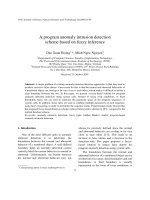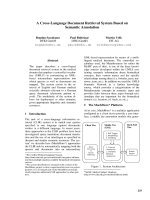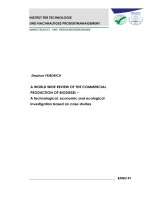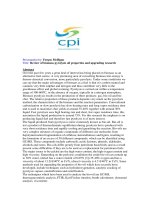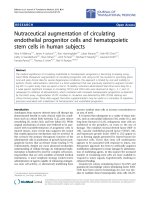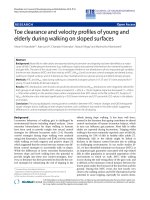A WORLD WIDE REVIEW OF THE COMMERCIAL PRODUCTION OF BIODIESEL – A technological, economic and ecological investigation based on case studies pot
Bạn đang xem bản rút gọn của tài liệu. Xem và tải ngay bản đầy đủ của tài liệu tại đây (5.27 MB, 164 trang )
Stephan FRIEDRICH
A WORLD WIDE REVIEW OF THE COMMERCIAL
PRODUCTION OF BIODIESEL –
A technological, economic and ecological
investigation based on case studies
____________________________________________________ BAND 41
Mag. Stephan FRIEDRICH
A WORLD WIDE REVIEW OF THE COMMERCIAL
PRODUCTION OF BIODIESEL –
A technological, economic and ecological
investigation based on case studies
SCHRIFTENREIHE UMWELTSCHUTZ UND RESSOURCENÖKONOMIE
DES INSTITUTES FÜR TECHNOLOGIE UND NACHHALTIGES PRODUKTMANAGEMENT
(ehemals Institut für Technologie und Warenwirtschaftslehre)
DER WIRTSCHAFTSUNIVERSITÄT
Herausgeber: o.Univ. Prof. Dr. Gerhard Vogel
BAND 41
© by Mag. Stephan Friedrich, Wien 2004
Medieninhaber:
Institut für Technologie und nachhaltiges Produktmanagement
der Wirtschaftsuniversität
A-1090 Wien, Augasse 2-6, Tel. + 43 1 31336/4806, Fax + 43 1 31336/706
Alle Rechte vorbehalten, auszugsweise Veröffentlichungen nur mit
Genehmigung, Quellenangabe und gegen Belegexemplar
FRIEDRICH Index of Contents
I
INDEX OF CONTENTS
1. INTRODUCTION 1
2. BIODIESEL: BASIC FACTS 3
2.1 Definition of Biodiesel 3
2.2 Demarcation 3
2.21 E-diesel 3
2.22 Fossil diesel 3
2.23 Crude vegetable oil 4
2.24 Ultra low sulphur diesel 4
2.25 Fischer-Tropsch diesel 5
2.3 Production process 5
2.31 Transesterification 5
2.32 Feedstock 8
2.4 Uses 12
2.5 Advantages of Biodiesel use 13
2.51 Supply security 14
2.52 Environmental aspects 15
2.53 Economic aspects 20
2.54 Agriculture 27
2.55 Biodiesel fuel properties 27
2.56 Quality standards 30
2.57 Engine warranties 31
2.6 Concerns/ barriers 31
2.61 Cold flow 31
2.62 Fuel stability 32
2.63 Fuel energy content 32
2.64 Material compatibility 33
2.7 History 33
3. METHODOLOGY 35
3.1 E-mail questionnaire 35
3.11 Questionnaire design 36
3.12 Administration 36
3.13 Survey analysis 36
3.14 Survey response rate 37
3.15 Target group 37
3.2 Online database 38
3.21 Questionnaire design 38
3.22 Administration 39
3.23 Survey analysis 40
3.24 Survey response rate 40
3.25 Target group 40
3.3 Webdirectory 41
FRIEDRICH Index of Contents
II
4. COUNTRY REPORTS 42
4.1 Asia & Australasia 42
4.11 Australia 42
4.12 People's Republic of China (including Hong Kong) 47
4.2 Europe 50
4.21 The European Union 50
4.22 Austria 61
4.23 Belgium 68
4.24 Czechia 71
4.25 France 75
4.26 Germany 82
4.27 Italy 92
4.28 Slovakia 96
4.29 Switzerland 101
4.210 UK 103
4.3 The Americas 108
4.31 The USA 108
5. SUMMARY 119
5.1 Introduction / history 119
5.2 Framework / legislation 119
5.21 Supportive taxation measures 121
5.22 Stakeholders 122
5.3 Production / quality / marketing 122
5.31 Plants 122
5.32 Feedstock 127
5.33 Quality standards / quality management 129
5.34 Marketing strategy / distribution system 130
5.4 Summary / forecast 131
6. BIBLIOGRAPHY 136
6.1 Books / reports 136
6.2 Articles and folders 138
6.3 Legislative texts 138
6.4 Lectures and talks given at conferences and symposia 139
6.5 Conversations held 139
6.6 Other information sources 140
6.61 E-mails to the author 140
6.62 Information from websites 142
7. APPENDIX 144
7.1 Appendix I: .doc-version (Microsoft Word) of database questionnaire 144
7.2 Appendix II: e-mail questionnaire 149
FRIEDRICH Index of Figures
III
INDEX OF FIGURES
Fig. 1: The three stages of Biodiesel industry development 2
Fig. 2: Chemical reaction of transesterification 6
Fig. 3: Reaction- equilibria of transesterification 7
Fig. 4: Flowchart of the esterification process 7
Fig. 5: Flowchart for the production of Biodiesel from oilseed rape in the UK 8
Fig. 6: Processing steps for oilseed extraction 10
Fig. 7: Price comparison of food and non-food rape oil with recycled frying oil 12
Fig. 8: World conventional crude oil production and forecast 1920-2060 14
Fig. 9: Profitability factors of Biodiesel on a multi-feedstock-basis 20
Fig. 10: Components of final diesel price 21
Fig. 11: Fossil diesel – Biodiesel price gap, Germany 2002 22
Fig. 12: Gasoil, rapeoil price development 1999 – 2002 (diesel (IPE),
rapeoil (FDM) month +3) 23
Fig. 13: Economies of scale in Biodiesel production 25
Fig. 14: Biodiesel in Ireland: total balance of macro-economic effects (in 1.000 IRP) 27
Fig. 15: Lubricity measurements (SLBOCLE) for Diesel, Biodiesel and blends 29
Fig. 16: World-wide request for information and response, by country 38
Fig. 17: World-wide requests for information and response, by country 41
Fig. 18: Capacity and production in Europe 1992-2003 55
Fig. 19: Set aside rate in the European Union (in % of total acreage) 57
Fig. 20: Comparison of current trend with White Paper objectives (in million tons) 59
Fig. 21: Capacity and production 1991-2005 65
Fig. 22: Biodiesel production, export, import and consumption
in the Czech Republic 1995-2001 73
Fig. 23: Biodiesel capacity, production and tax exempt quota 1991-2003 79
Fig. 24: Harvest fluctuation of colza for Biodiesel usage, 1993-2000 80
Fig. 25: Biodiesel production capacity 1998-2003 87
FRIEDRICH Index of Figures
IV
Fig. 26: Price gap fossil diesel – Biodiesel 1999-2002 89
Fig. 27: Development of the Biodiesel filling station network in Germany, 1994-2002 90
Fig. 28: Biodiesel sales 1991-2002 91
Fig. 29: Producer´s contributions to national Biodiesel production in Italy 94
Fig. 30: Biodiesel volumes in Italy 1993-2003 95
Fig. 31: Biodiesel production in Slovakia, market shares 2001 99
Fig. 32: Biodiesel volumes in Slovakia 2000-2004 99
Fig. 33: Farmland for oilseeds 1999 106
Fig. 34: Current and proposed US legislation 111
Fig. 35: Biodiesel sales development in the USA, fiscal years 1999-2002 114
Fig. 36: Feedstock sources 2002-2016 115
Fig. 37: Allocation of public fuelling stations 117
Fig. 38: Stages of Biodiesel involvement world-wide, by country 123
Fig. 39: World production 1991- 2003 (in 1.000 t) 124
Fig. 40: World production of oilseed, 2001/2002 (totalling 320,72 Million t) 128
Fig. 41: Biodiesel feedstock sources 1998 129
Fig. 42: World transportation energy use by region 1990, 1999, 2010 and 2020 132
Fig. 43: Diesel fuel demand by region, 1999 and 2020 (in million barrels per day) 133
Fig. 44: EU Directive targets for Biodiesel consumption 2005/2010 134
FRIEDRICH Index of Tables
V
INDEX OF TABLES
Tab. 1: The boiling range of typical refinery products 4
Tab. 2: World-wide soy production 2001 (in million t) 9
Tab. 3: EPA emission assessment (B100, B20 compared to fossil diesel) 16
Tab. 4: Lifecycle GHG emissions for 2% Biodiesel 17
Tab. 5: Lifecycle GHG emissions for 20% Biodiesel 18
Tab. 6: Lifecycle GHG emissions for 100% Biodiesel 19
Tab. 7: Profit margin calculation for 6 existing Biodiesel production plants 24
Tab. 8: Scenarios for Biodiesel production 25
Tab. 9: Cetane number and energy content for Biodiesel fuels 28
Tab. 10: Cold flow characteristics of Biodiesel blends 32
Tab. 11: Comparison of Diesel/Biodiesel energy content and energy efficiency 33
Tab. 12: Biodiesel industry stakeholders in Australia 44
Tab. 13: Biodiesel industry stakeholders in China 48
Tab. 14: Tax regulations and financial incentive programs in European Countries 51
Tab. 15: Biodiesel industry stakeholders in the European Union 54
Tab. 16: European capacity and estimated production of Biodiesel 2002 (in 1.000 t) 56
Tab. 17: Marketing strategies of EU member states 58
Tab. 18: Diesel consumption in the European Union 1998 (in 1.000 t) 60
Tab. 19: Minimum target quantities of biological diesel fuel production
in the European Union 2005-2010 (in 1.000 t) 60
Tab. 20: Biodiesel industry stakeholders in Austria 63
Tab. 21: Biodiesel producers 2003 64
Tab. 22: Planned production plants 64
FRIEDRICH Index of Tables
VI
Tab. 23: Feedstock- usage and application 1994-2001 65
Tab. 24: Annual reduction in emissions when 25 busses are filled up with Biodiesel 67
Tab. 25: Biodiesel industry stakeholders in Belgium 69
Tab. 26: Biodiesel industry stakeholders in Czechia 72
Tab. 27: Rapeseed oil production in the Czech Republic 1994-2001 73
Tab. 28: Authorized production quota (tax exempt) 76
Tab. 29: Biodiesel industry stakeholders in France 78
Tab. 30: Obligatory set-aside land, % of total acreage 80
Tab. 31: Urban fleets using Biodiesel 81
Tab. 32: Biodiesel industry stakeholders in Germany 85
Tab. 33: Biodiesel plants in operation 2003 86
Tab. 34: Biodiesel plants in construction 2003 87
Tab. 35: Biodiesel industry stakeholders in Italy 93
Tab. 36: Biodiesel industry stakeholders in Slovakia 98
Tab. 37: Biodiesel industry stakeholders in Switzerland 102
Tab. 38: Excise duty on transport fuels 104
Tab. 39: Biodiesel industry stakeholders in the United Kingdom 105
Tab. 40: Biodiesel industry stakeholders in the United States 113
Tab. 41: NBB (National Biodiesel Board) corporate members producing Biodiesel 113
Tab. 42: Sales development fiscal years 1999-2002 116
Tab. 43: Regulatory motives and their different implementation measures 120
Tab. 44: Diesel oil retail prices in selected countries 121
Tab. 45: Countries on the cusp of commercial Biodiesel production 127
Tab. 46: Existing Diesel vehicle warranties for Biodiesel operation 130
Tab. 47: Marketing: examples of market segmentation and niches of risk reduction 131
FRIEDRICH Index of Abbreviations
VII
INDEX OF ABBREVIATIONS
o
C Degree Celsius
€ Euro
a Year (annum)
approx. approximately
ASTM American Society for Testing and Materials
BD Biodiesel
CEN European Committee for Standardization
CFC Fluor-chlorinated hydrocarbons
CNG Compressed natural gas
CO
2
Carbon dioxide
DG General Directorate
e.g. Example given
EPA US Environmental Protection Agency
EU The European Union
FAME Fatty acid methyl ester
FFA Free fatty acids
g Gram
G Giga
GATT General Agreement on Tariffs and Trade
GHG Greenhouse gas
h hour
ha Hectar
i.e. That is (id est)
J Joule
kg Kilogram
l Liter
LPG Liquid petroleum gas
M Mega
mill Million
NO
x
Nitrogen oxides
PM
Particulate matter
ppm Parts per million
R&D Research and development
RME Rapeseed oil methyl ester
SME Sunflower methyl ester
t Metric ton
t/a Tons per year
UK United Kingdom
ULSD Ultra low sulphur diesel
US The United States of America
VAT Value-added-tax
VOC Volatile organic compounds
VOME Vegetable oil mehtyl ester
FRIEDRICH 1. Introduction
1
1. INTRODUCTION
As early as the beginning of the 20
th
century Rudolf Diesel proposed vegetable oil as
fuel for his engine.
1
A short time later, before and during World War Two, vegetable
oil was examined in “up-to-date” diesel engines. In 1940 first trials with vegetable oil
methyl and ethyl esters were carried out in France and, at the same time, scientists in
Belgium were using palm oil ethyl ester as a fuel for buses.
2
In 1973, the oil crisis
refocused attention on and interest for local energy sources. In recent decades, research
concerning and knowledge about the external benefits of renewable raw materials have
intensified the efforts for sustainable energy sources. Biodiesel plays a major role in
this field because of the world-wide research, development and deployment activities
of this sustainable energy source.
3
Due to this recent increased awareness and development, the objective of this thesis is
to provide a world-wide review of the production of Biodiesel.
For the description of the Biodiesel scene a three-stage development is referred to:
4
• Phase I consists of the very first ideas and thoughts of Biodiesel being used as a
fuel until the actual adaptation of the ideas on the part of the decision makers
who are then motivated to put these ideas into practice. The end of Phase I (=
beginning of Phase II) is the political decision to invest money and other
resources to Biodiesel research.
• Phase II is characterised by research efforts, pilot projects, setting of frame
conditions and financially supported technical trials.
• Countries in Phase III show a Biodiesel economy based primarily on a feasible
economic production, distribution and use of Biodiesel, and a self supportive
Biodiesel economy.
1
KNOTHE, G., DUNN, R.O., BAGBY, M.O.: Biodiesel: The Use of Vegetable Oils and Their Derivatives as Alternative Diesel
Fuels, Oil Chemical Research, National Center for Agricultural Utilization Research, Agricultural Research Service, U.S.
Department of Agriculture, Peoria IL 1996, Internet:
reports/gen/19961201_gen-162.pdf [6.9.2003]
2
KÖRBITZ, W., Austrian Biofuels Institute, 14.2.2003
3
ABI (Austrian Biofuels Institute): In response to the e-mail questionnaire sent by the author, Austria, Vienna 2002
4
EIBENSTEINER, F., DANNER, H.: Biodiesel in Europe, System Analysis, Non-Technical-Barriers, Wels 2000, p. 41,
Internet: [10.10.2002]
FRIEDRICH 1. Introduction
2
Fig. 1: The three stages of Biodiesel industry development
Source: EIBENSTEINER F., DANNER, H.: Biodiesel in Europe, System Analysis, Non-Technical-Barriers, Wels 2000, p. 41
This diploma thesis concentrates on 12 countries that have already entered Phase III.
Country reports for these nations provide information on the history and the
development of Biodiesel activities, on the legal framework, about existing and
projected capacities, current production figures, feedstock used, quality standards and
market issues including the main stakeholders of the national Biodiesel industry.
In order to give a global picture, a preliminary introduction regarding the nature
(advantages, barriers) and the various applicabilities of Biodiesel, its sources
(feedstock) as well as the environmental and economic background is provided.
FRIEDRICH 2. Biodiesel: Basic facts
3
2. BIODIESEL: BASIC FACTS
2.1 Definition of Biodiesel
Biodiesel is defined as the mono-alkyl esters of fatty acids derived from vegetable oils
or animal fats. In simple terms, Biodiesel is the product you get when a vegetable oil
or animal fat is chemically reacted with an alcohol to produce a new compound that is
known as a fatty acid alkyl ester. A catalyst such as sodium or potassium hydroxide is
required.
5
Glycerol is produced as a by-product. The approximate proportions of the
reaction are:
100 l of oil + 10 l of methanol = 100 l of Biodiesel + 10 l of glycerol
6
2.2 Demarcation
2.21 E-diesel
Ethanol (CH
3
CH
2
OH) is a liquid, biodegradable fuel produced from corn, barley or
wheat which is fermented and distilled into a pure (200 proof ) product. It has a higher
octane rating than petrol but a lower Cetane rating than diesel.
7
It is generally used as a
blend with petrol, but the use of additives has also enabled the development of
ethanol-diesel blends (10% or 15% ethanol) that have shown some promise lately.
8
2.22 Fossil diesel
Fossil diesel fuel is derived from petroleum through a refining process. The primary
purpose of a petroleum refinery is to separate the complex mixture of hydrocarbons
into usable products. Petroleum is separated into fractions whose distinguishing
feature is their different boiling points. Tab. 1 shows the boiling point ranges
corresponding to the various commercial fuels.
5
Internet: [5.9.2003]
6
Internet: [4.1.2003]
7
HOPKINSON L., SKINNER S.(Civic exchange, the Asia Foundation): Cleaner Vehicles and Fuels, The Way Forward; Hong
Kong, 2001; via e-mail to the author, 2002
8
Internet: [4.1.2003]
FRIEDRICH 2. Biodiesel: Basic facts
4
Product Boiling Range (
o
C)
Liquid Petroleum Gas (LPG)
-40 - 0
Gasoline
30 - 200
Kerosene, Jet Fuel, Diesel
170 - 270
Furnace Oil
180 - 340
Lube Oils
340 - 540
Residual Oil
340 - 650
Asphalt
540 +
Petroleum Coke
Solid
Tab. 1: The boiling range of typical refinery products
Source: Internet: www.me.iastate.edu/biodiesel/Pages/bio16.html [6.9.2003]
As indicated in the table, kerosene, jet fuel (Jet A), and diesel fuel are the same
fraction of petroleum. In most refineries, this fraction is straight run, that means, it is
produced directly from compounds that were present in the crude petroleum.
9
2.23 Crude vegetable oil
Attempts have been made to use raw oils in engines since at least 1900 when the Otto
Company demonstrated the use of peanut oil in a diesel engine at the Paris
Exhibition.
10
Most experiments of this type have shown that diesel engines run on raw oils, but
performance will degrade over time. After a period of several hundred hours, engine
inspections show large amounts of fuel dilution of the lubricating oil, thus causing
thickening and sludge formation. Piston rings are often damaged or broken because of
excessive carbon deposits. Fuel-injection equipment can be coated with varnish
deposits. The best experience when using raw oils in engines seems to come from
indirect-injection engines using only 5-10% blends of the oil in diesel fuel.
11
2.24 Ultra low sulphur diesel
Ultra Low Sulphur Diesel (ULSD) is fossil diesel that has been further treated in order
to lower its sulphur content to less than 50ppm or 0,005%.
Significant refinery reconfigurations are needed in order to produce ULSD.
12
9
Internet: [4.1.2003]
10
Internet: [6.9.2003]
11
Internet: [4.1.2003]
12
MITZNER, M.: Ultra Low Sulphur Diesel Capabilities; Hydrocarbon Engineering, Farnham/Surrey March 2002,
Internet: [8.2.2003]
FRIEDRICH 2. Biodiesel: Basic facts
5
2.25 Fischer-Tropsch diesel
Fischer-Tropsch (F-T) diesel is a synthetic diesel fuel produced from natural gas, coal
or biomass. It is colourless, odourless and low in toxic emissions.
Simplified the Fischer-Tropsch reaction is:
13
CO + 2H
2
→ CH
2
+ H
2
0
2.3 Production process
2.31 Transesterification
Biodiesel is made through a chemical process called transesterification whereby the
glycerine is removed from the fat or vegetable oil. Biodiesel is thus an ester. If
methanol is used in the production process it is a methyl ester; if ethanol is used it is an
ethyl ester.
14
For more than 50 years, patent literature has proposed many possibilities for
transesterification process technology, including those made by Ballestra, BDI,
Connemann, ENA-Biodiesel, Energea, Kirchfeld, Lurgi, IFP, Westfalia and others.
15
Generally speaking there are three basic ways for the production of to methyl ester
from oils and fats:
16
• Base catalyst transesterification of the oil (triglycerides) with methanol
• Directed acid catalyzed esterification of the free fatty acids (FFA) with
methanol
• Conversion of the oil to FFA and then to methyl esters with acid catalysis
13
Internet: [8.2.2003]
14
LEVELTON ENGINEERING: Assessment of Biodiesel and Ethanol diesel blends, greenhouse gas emissions, exhaust
emissions and policy issues, Ottawa 2002, p. 24, via e-mail to the author
15
Internet: [8.2.2003]
16
NBB (National Biodiesel Board): Biodiesel Production Technology Overview. Gen 004.
Internet: [10.9.2002]
FRIEDRICH 2. Biodiesel: Basic facts
6
The majority of the methyl esters produced today are produced using the base
catalyzed reaction because it is the most economic for several reasons:
17
• A low temperature (up to 65,5
o
C) and ambient pressure (20 psi)
• It yields high conversion (98%) with minimal side reactions and reaction time
• It is the direct conversion to methyl ester with no intermediate steps
• Exotic materials of construction are not necessary
The chemical reaction is:
R’ R’’ R’’’ = oil acids; R = (CH
2
)
x
CH
3
Fig. 2: Chemical reaction of transesterification
Source: LEVELTON ENGINEERING: Assessment of Biodiesel and Ethanol diesel blends, greenhouse gas emissions,
exhaust emissions and policy issues, Ottawa 2002, p. 24, via e-mail to the author
The chemistry of the exchange (several parallel acting reaction equilibria and phase
balances) is described in Fig. 3, whereas Fig. 4 shows the flowchart of the processing
steps needed.
17
NBB (National Biodiesel Board): Biodiesel Production Technology Overview. Gen 004.
Internet: [10.9.2002]
FRIEDRICH 2. Biodiesel: Basic facts
7
Fig. 3: Reaction- equilibria of transesterification
Source: Internet: [10.10.2002]
Fig. 4: Flowchart of the esterification process
Source: National Biodiesel Board production fact sheet, Internet: [10.11.2002]
FRIEDRICH 2. Biodiesel: Basic facts
8
Fig. 5 illustrates the whole process chain for Biodiesel production with typical UK
values for all the principal raw materials, products, co-products, by-products and waste
products involved.
Fig. 5: Flowchart for the production of Biodiesel from oilseed rape in the UK
Source: MORTIMER, N.D.: Evaluation of the comparative energy, environmental and socio-economic costs and benefits of
Biodiesel, Draft Report for the Department for Environment, Food and Rural Affairs, London 2002, p. 23
2.32 Feedstock
All vegetable oil and animal fats consist primarily of triglyceride molecules.
The properties of the triglyceride and the Biodiesel fuel are determined by the amounts
of each fatty acid that are present in the molecules.
18
Basically, a large amount of feedstock sources are available. Besides the traditional
crops as rapeseed and sunflower they also include peanut, cottonseed, lard, linseed,
tung, cocoa, hemp and palm.
19
Only the main feedstock sources actually being used in
the commercial production of Biodiesel will be discussed in this study.
18
Internet: [4.1.2003]
19
KÖRBITZ, W., Austrian Biofuels Institute, 2.8.2002
FRIEDRICH 2. Biodiesel: Basic facts
9
2.321 Rapeseed
Rapeseed is a member of the Brassica family, which includes broccoli, cabbage,
cauliflower, mustard, radish and turnip. Rapeseed oil crushed from 00-rapeseed (an
improved variant of the original rapeseed, with less erucic acid and glucosinolate
content) was the first type of vegetable oil used for transesterification and rather by
chance this oil is highly suitable for production of quality Biodiesel: With a content of
approx. 60 % monounsaturated oleic-fatty-acid and only approx. 6 % saturated fatty
acids it shows both good stability and winter operability.
20
Rapeseed contains approximately 22% protein and 40% oil, with modern breeds
reaching 48 % oil content. Compared to soybeans, rapeseed has more than twice the
oil content but a lower protein level.
21
The seed is crushed for the oil contained (the
crushing process is essentially the same as that for soybeans),
the by-product is a
protein rich meal used by the intensive livestock industry.
22
2.322 Soybean
Soybeans are a bushy, leguminous plant, Glycine max, native of South-East Asia that
is grown for the beans, which are used widely in the food industry, for protein in cattle
feed and for oil production.
23
The beans typically contain about 18 - 20% oil, 40% protein, 17% cellulose, with the
reminder containing sugar, ash, fibre and other components. Soybeans are the world’s
largest oilseed crop, with production at about 56% of the world’s total oilseeds. The
United States is the largest single producer of soybeans:
24
Country Production Final stock
United States
77,12 6,94
Brasil
39 6,75
Argentina
26 5,9
China
15 4,29
WORLD
175,4 26,18
Tab. 2: World-wide soy production 2001 (in million t)
Source: Internet: p.24
20
ABI (Austrian Biofuels Institute): „World-wide Trends in Production and Marketing of Biodiesel”, ALTENER – Seminar “New
Markets for Biodiesel in Modern Common Rail Diesel Engines” ,University for Technology in Graz, Graz 2000; via e-mail to
the author
21
LEVELTON ENGINEERING: Assessment of Biodiesel and Ethanol diesel blends, greenhouse gas emissions, exhaust
emissions and policy issues, Ottawa 2002, p. 6 via e-mail to the author
22
Internet: p.1 [1.2.2003]
23
Internet: p.1 [1.2.2003]
24
LEVELTON ENGINEERING: Assessment of Biodiesel and Ethanol diesel blends, greenhouse gas emissions, exhaust
emissions and policy issues, Ottawa 2002, p. 3, via e-mail to the author
FRIEDRICH 2. Biodiesel: Basic facts
10
Soybeans are crushed and processed to separate the oil from the remainder of the
plant. A typical crushing operation is depicted in Fig. 6:
Fig. 6: Processing steps for oilseed extraction
Source: LEVELTON ENGINEERING: Assessment of Biodiesel and Ethanol diesel blends, greenhouse gas emissions,
exhaust emissions and policy issues, Ottawa 2002, p. 5, via e-mail to the author
FRIEDRICH 2. Biodiesel: Basic facts
11
2.323 Beef tallow, lard
The rendering process recycles animal and poultry by-products, including bones, trim,
fat, offal and feathers into a broad range of commercial tallow (animal/vegetable fat)
and protein products (meat and bone, poultry, feather, blood, fish and porcine meals).
Tallows are used in the manufacture of products such as cosmetics, soaps, shampoos,
candles, lubricants, paints, tires, perfumes, textiles, plastics, inks, polishes, cleaners
and solvents. Different grades of tallow are produced to meet the varying needs. They
are also an important source of fatty acids and glycerine for the chemical industry.
25
2.324 Recycled frying oil
Biodiesel made from recycled frying oil has come to be known as McDiesel, because
one large source of waste cooking oil is McDonald’s restaurants.
26
The production of Biodiesel from recycled frying oil is cheaper than from other
feedstock sources; its capacity is nevertheless limited and requires recycling
infrastructure; therefore, its main application seems to be in congested areas.
Recycled frying oils are processed together with tallow by rendering
27
(e.g. Canada),
or collected and processed separately (e.g. Austria, Germany) where they are
considered special waste by law.
25
LEVELTON ENGINEERING: Assessment of Biodiesel and Ethanol diesel blends, greenhouse gas emissions, exhaust
emissions and policy issues, Ottawa 2002, p. 7, via e-mail to the author
26
Internet: [14.12.2002]
27
LEVELTON ENGINEERING: Assessment of Biodiesel and Ethanol diesel blends, greenhouse gas emissions, exhaust
emissions and policy issues, Ottawa 2002, p. 8, via e-mail to the author
FRIEDRICH 2. Biodiesel: Basic facts
12
Fig. 7: Price comparison of food and non-food rape oil with recycled frying oil
Source: EIBENSTEINER, F., DANNER, H.: Biodiesel in Europe, System Analysis, Non-Technical-Barriers, Wels 2000,
p. 18, Internet: [10.10.2002]
2.4 Uses
There are many ways to use alkyl esters including use as solvents and as chemical
intermediates for the formation of detergents. However, the application most
interesting is as fuel. Fuel applications can be divided into three categories:
28
• Pure Biodiesel (B100)
Biodiesel can be used in its pure form, also known as neat Biodiesel or B100. This is
the approach that provides the most reduction in exhaust particulates, unburned
hydrocarbons, and carbon monoxide. It is also the best way to use Biodiesel when its
non-toxicity and biodegradability are important. Marine applications may be
important for B100. Although neat Biodiesel would not be expected to cause any
operational problems, its solvent properties are at their highest intensity and may cause
problems with loosening of varnish deposits in fuel tanks and lines, degradation of fuel
lines because some elastomers are not compatible with Biodiesel (such as BUNA
rubbers), and cause paint removal near fuel fill ports.
28
Internet: [4.1.2003]
FRIEDRICH 2. Biodiesel: Basic facts
13
• Blends (typically 20-50%)
Biodiesel will blend with petroleum-based diesel fuel in any proportion so it is
common to use blends of 20 to 50% Biodiesel in 80 to 50% fossil diesel. Blends
reduce the cost impact of Biodiesel while retaining some of the emissions reductions.
Most of the these reductions appear to be proportional to the percentage of Biodiesel
used.
• As an additive, 1-2% (B02)
Tests for lubricity have shown that Biodiesel is a very effective lubricity enhancer.
Even as little as 0,25% can have a measurable impact and 1-2% is enough to convert a
very poor lubricity fuel into an acceptable fuel. Although these levels are too low to
have any impact on the Cetane number of the fuel or the emissions from the engine,
the lubricity provides a significant advantage at a modest cost.
2.5 Advantages of Biodiesel use
Biodiesel is renewable, non-toxic, and biodegradable. Depending on the audience,
these may or may not be strong advantages. While Biodiesel is definitely renewable,
the fact that it cannot displace a significant fraction of our current petroleum-based
fuel consumption means that it does not really allow us to make much progress toward
a sustainable energy supply. Non-toxicity and biodegradability are useful
characteristics but they are only significant when the fuel is used in its pure form
(B100) as is common in Germany and Austria. For the 20% and lower blends that are
common in the United States, the diesel fuel portion of the blend determines the
toxicity and biodegradability. Biodiesel does provide a reduction in harmful emissions
(SO
x
, CO, HC, PM, soot, PAHs, as well as NO
x
in optimised Diesel engines) as well
as in net CO
2
emissions. Although the amount of CO
2
emitted from the exhaust pipe
per kilowatt of power is essentially the same as for petroleum diesel fuel, the carbon
was originally removed from the atmosphere so there is little net change in
atmospheric carbon dioxide.
29
It is obvious that Biodiesel is not going to completely replace petroleum-based diesel
fuel in the near future. If all of the vegetable oil and animal fat were used to produce
Biodiesel, we could only replace about 15% of the current demand for on-highway
diesel fuel.
30
Nevertheless, in addition to Biodiesel´s characteristics already mentioned, there are
good arguments to concern about these 15%; the most prominent will be presented in
more detail in the following pages.
29
Internet: [10.1.2003]
30
Internet: [10.1.2003]
FRIEDRICH 2. Biodiesel: Basic facts
14
It should be mentioned that technical, economic and environmental factors are not
sufficient to fully explain the use or non-use of a given fuel; other factors such as
• sociological and cultural aspects
• organisational aspects
• institutional, structural and political aspects
would have to be investigated
31
, but they were partly neglected as this would have
gone beyond the scope of this work.
2.51 Supply security
Biodiesel decreases the country's dependence on imported petroleum, a necessity in
view of diminishing reserves of fossil energy sources.
Fig. 8: World conventional crude oil production and forecast 1920-2060
Source: LAHERRERE, J.: Hydrocarbons Resources, Forecast of oil and gas supply to 2050, Petrotech 2003,
New Delhi 2003 Internet: [8.2.2003]
Obviously, this reason should not be overemphasized since the percentage of the
country's fuel supply that can be replaced with Biodiesel will be small. Taken the
situation of Europe with an anticipated annual growth of the transport sector of 2
percent
32
and a maximum 8 percent substitution by biofuels, the positive effects gained
are offset by the growth in the use of fossil fuels in less than four years.
33
31
KÖRBITZ, W., Austrian Biofuels Institute, 10.10.2002
32
European Commission: “Green Paper on Security of Supply” , COM (2000) 769
33
JONK, G.: Background paper 18-03-2002, On the use of biofuels for transport, Internet: />Biofuels-background-18-03-02.pdf [20.12.2002]
FRIEDRICH 2. Biodiesel: Basic facts
15
2.52 Environmental aspects
Biodiesel is renewable and does not contribute to global warming due to its closed
carbon cycle. Because the primary feedstock for Biodiesel is a biologically-based oil
or fat, which can be grown season after season, Biodiesel is renewable. And, since the
carbon in the fuel was originally removed from the air by plants, there is no net
increase in carbon dioxide levels.
34
2.521 Energy balance
The energy output for Biodiesel from rape seed (the oil share only is considered) is
about 4 to 5 times the input. If the whole plant is considered, the output is 7,4 times the
input.
35
,
36
2.522 CO
2
reduction potential
The CO
2
reduction potential of RME (rape methyl ester, i.e. Biodiesel made from
rapeseed oil) is considered to be 1,2 kg CO
2
/kg of substituted fossil diesel.
Additionally by-product credits could be achieved. If the use of rape seed press cake as
animal food is considered, 0,7 kg CO
2
/kg substituted diesel could be calculated. For
substitution of synthetic glycerol 0,8 kg CO
2
/kg substituted diesel can be included.
The whole CO
2
advantage compared with fossil diesel would be 3,66 kg CO
2
/kg
substituted diesel if rape straw burning, Biodiesel, animal food and glycerol are
considered.
37
Other studies
38
calculate the avoided CO
2
to 3,2 kg/l substituted fossil diesel.
2.523 Emissions
In 2002 the US Environmental Protection Agency (EPA) published a fact sheet on
Biodiesel. They noted that the actual emission impact of the use of Biodiesel varies
from engine to engine. Their summary of the emissions impact, relative to fossil diesel
fuel, for B20 and B100 for an engine that takes full advantage of the fuel’s clean
burning properties are shown in the following table.
34 Internet: [10.1.2003]
35
UBA Berlin: Ökologische Bilanz von Rapsöl bzw. Rapsölmethylester als Ersatz von Dieselkraftstoff, Berlin 1993
36
CONNEMANN, J., FISCHER, J.: Biodiesel in Europe 1998, International liquid biofuels congress, Curitiba Parana Brazil,
July 19 - 22 1998
37
EIBENSTEINER, F., DANNER, H.: Biodiesel in Europe, System Analysis, Non-Technical-Barriers, Wels 2000, p. 31,
Internet: [10.10.2002]
38
SCHÖPE, M.: Economic aspects of Biodiesel production in Germany; 2
nd
European Motor Biofuels Forum, Graz 1996
